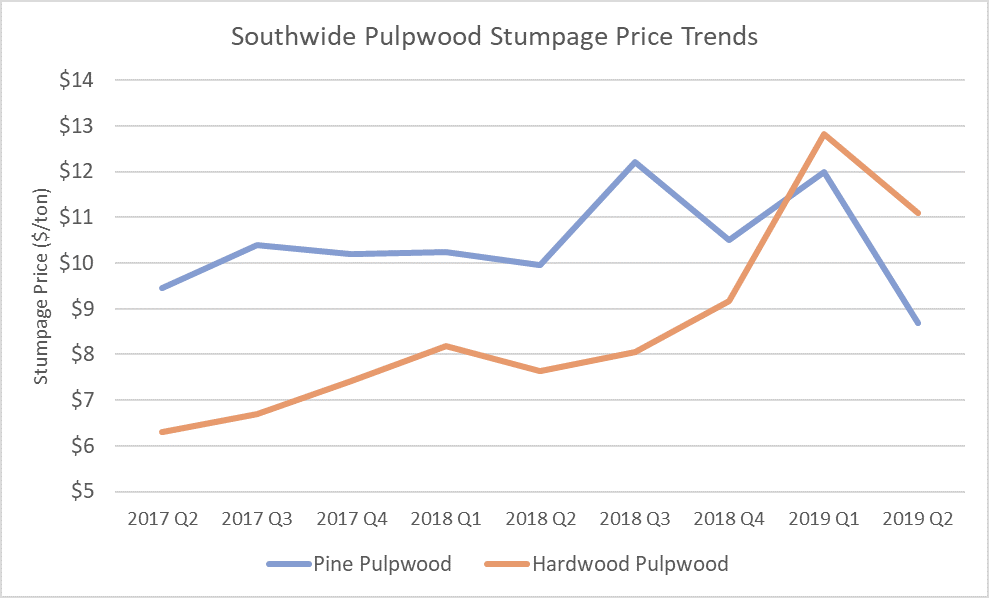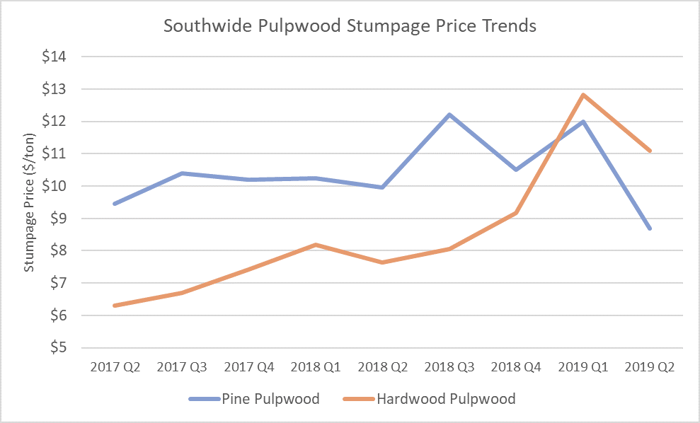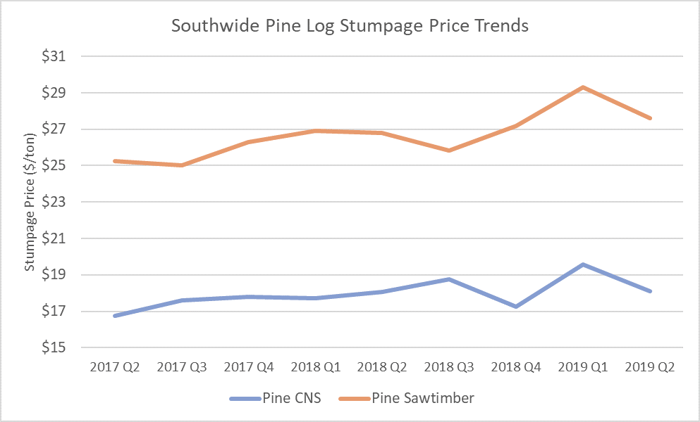
After skyrocketing in 1Q2019 due to prolonged wet-weather challenges, southern timber prices reversed course sharply in 2Q2019. Not surprisingly, pulpwood products demonstrated more volatility than did pine log products. However, the overall trend of all timber products was on a considerable slide in the second quarter, as the weighted average price per ton decreased -8.8 percent.
It is worth noting that the higher-than-normal rainfall totals the South experienced during 2H2018 and 1Q2019 had a significant impact on the temporary increase in timber prices, as timberlands were simply inaccessible or unworkable in many areas. While weather patterns have returned to more normal, dry summertime conditions in most of the South, the western region is still facing precipitation challenges brought about by hurricane Barry.
Pulpwood
On a Southwide basis, pine pulpwood prices decreased -26.9 percent to $8.68/ton during 2Q2019, and all regions saw prices drop for this product. The West-South experienced the largest decrease of -40.6 percent to $7.98/ton followed by the Mid-South, which decreased -18.4 percent to $6.82/ton. Pine pulpwood prices in the East-South dropped -16.1 percent to $11.97/ton.
Hardwood pulpwood prices Southwide demonstrated a significant correction as well, dropping -12.5 percent during 2Q to $11.09/ton. The East-South region experienced the largest decrease, dropping by -47.2 percent to $6.33/ton, and the Mid-South decreased -8.17 percent to $11.92/ton. However, prices in the West-South rose by +6.14 percent to $13.83/ton.

Pine Log
Pine chip-n-saw prices also experienced a significant decrease to $18.10/ton on a Southwide basis, a drop of -9.82 percent. The Mid-South experienced the largest decrease of -16.9 percent to $16.04/ton. The East-South dropped -4.6 percent to $21.06/ton, and the West-South region inched down -0.6 percent to $14.85/ton.
Pine sawtimber prices decreased at a lower rate than did the other products, sinking -3.8 percent to a Southwide average of $27.62/ton; two of the three regions experienced decreases. The Mid-South dropped -11.3 percent to $24.84/ton, the East-South sank -7.8 percent to $25.63/ton, and prices in the West-South were flat at +0.4 percent to $30.74/ton.

Outlook
Real gross domestic product (GDP) increased at an annual rate of 2.1 percent in 2Q2019 according to the "advance" estimate released by the Bureau of Economic Analysis. After revisions for 1Q, real GDP increased 3.1 percent. Despite strong economic indicators, employment numbers and declining interest rates, US housing starts were down in both May and June, which is historically the mid-point of peak building season.
As we noted in our 1Q recap of southern timber prices, we believe the sudden upsurge of prices during 1Q2019 was driven by prolonged and excessively wet weather throughout the region, and we forecasted a downward correction in 2Q—"especially if housing starts fail to gain any clear momentum through the early part of the summer.” That dynamic has largely come to pass. Based on declining prices and demand for finished lumber across North America, as well as mill curtailments and closures in the Pacific Northwest and British Columbia, we look for Southwide timber prices to continue to trend downward at a slower pace into 3Q2019. There simply don’t appear to be any demand drivers on the horizon that would cause prices to increase.
However, the potential inventory build in 3Q is a driver that could impact southern timber prices over the next several months. As we enter the fall season, procurement teams will plan ahead in an effort to avoid the supply pinch and high prices that were experienced last winter. That uncertainty may be enough to drive prices higher in order to reduce inventory risk.





